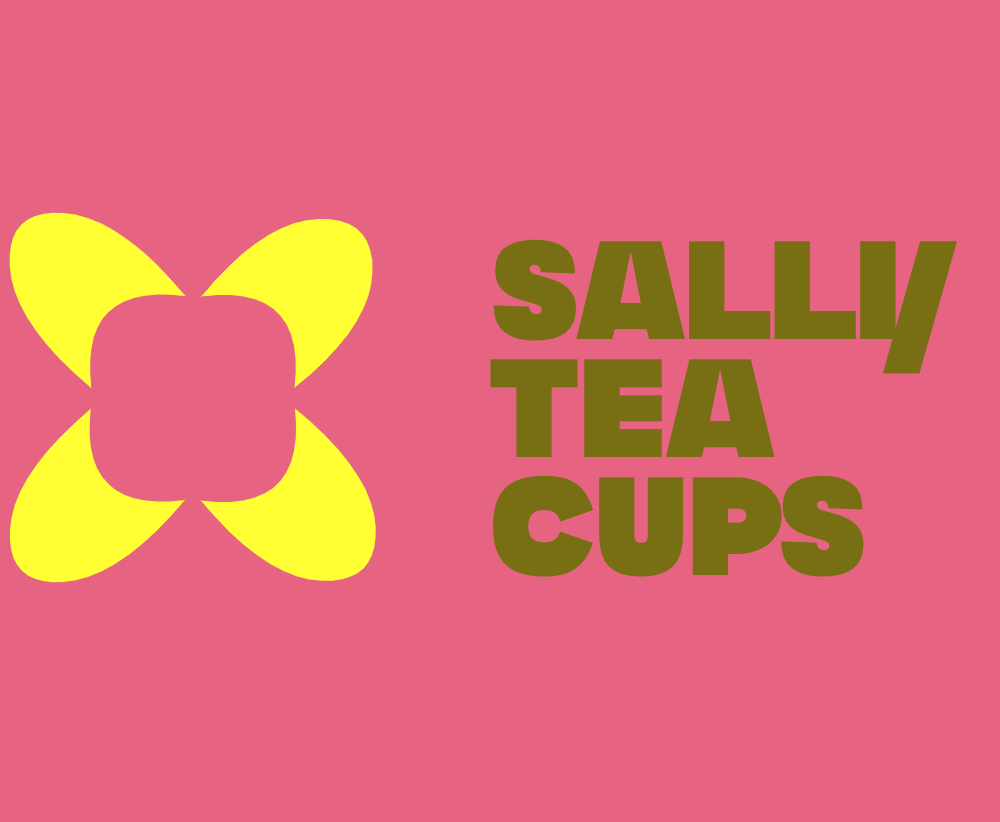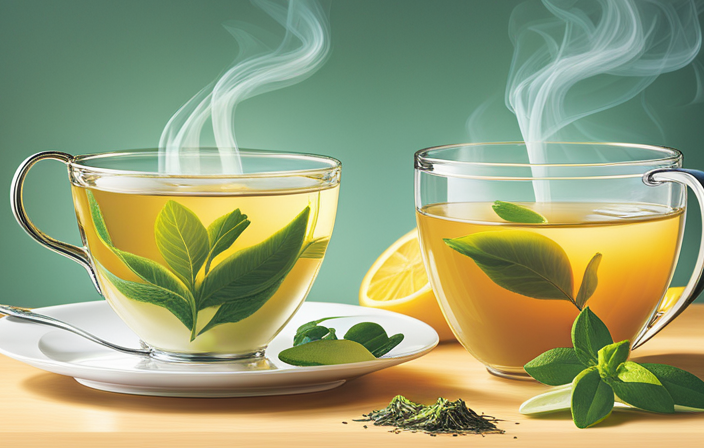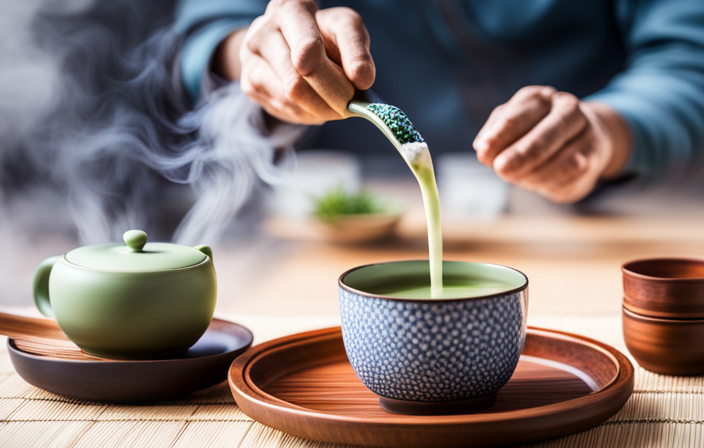Rooibos Tea
Where Is Rooibos Grown

Coincidentally, I have always been fascinated by the origins of the beverages I consume. So, when I stumbled upon the question, ‘Where is rooibos grown?’, I couldn’t help but delve into the world of this unique and flavorful tea.
Rooibos, also known as red bush tea, is primarily grown in the idyllic regions of South Africa. The plant, scientifically known as Aspalathus linearis, thrives in the sandy soils and Mediterranean-like climate of the Western Cape province.
As I delved deeper into my research, I discovered the ideal growing conditions required for the cultivation of this remarkable plant. From the cultivation and harvesting methods to the demand for organic rooibos, I was amazed by the intricate details that contribute to the production of this beloved tea.
Join me as we explore the mystical landscapes where rooibos is grown, support local farmers, and even embark on rooibos tours to witness the process firsthand.
Key Takeaways
- Rooibos is primarily grown in the Western Cape province of South Africa, specifically in the Cederberg region.
- The ideal growing conditions for rooibos include high elevations, sandy soil, warm days, cool nights, and moderate rainfall.
- Rooibos is predominantly harvested by hand to ensure the highest quality leaves are selected.
- The regions where rooibos is grown in South Africa include Cederberg, Sandveld, Olifants River, and Clanwilliam.
The Origins of Rooibos
You might be surprised to learn that rooibos is grown exclusively in the Cederberg region of South Africa. This unique plant, known for its numerous health benefits, has a rich history that dates back centuries.
The indigenous Khoisan people were the first to discover its potential and used it for its medicinal properties. Today, rooibos is enjoyed worldwide for its natural sweetness and soothing qualities.
The process of producing rooibos involves harvesting the leaves, fermenting them, and then drying them in the African sun. This careful processing method is what gives rooibos its distinct flavor and vibrant red color.
The Cederberg region provides the ideal growing conditions for rooibos, with its sandy soil, cool winters, and hot summers. It is these unique factors that contribute to the exceptional quality and taste of rooibos tea.
Ideal Growing Conditions for Rooibos
In the Cederberg region of South Africa, the ideal conditions for cultivating rooibos include high elevations and sandy soil. Rooibos thrives in an ideal climate characterized by warm days and cool nights, with temperatures ranging between 20 to 30 degrees Celsius.
It requires a moderate amount of rainfall, around 450 to 600 millimeters per year, and prefers well-drained soil to prevent waterlogging. The sandy soil in this region provides excellent drainage and allows the rooibos plant’s roots to penetrate deeply.
This unique combination of high elevations and sandy soil creates the perfect environment for rooibos to flourish. With these ideal growing conditions, rooibos plants develop strong and healthy, producing the highest quality leaves.
As we delve into rooibos cultivation and harvesting, let’s explore the next step in the process.
Rooibos Cultivation and Harvesting
I’ve gained extensive knowledge about Rooibos cultivation and harvesting.
Rooibos is primarily cultivated on commercial farms where specific growing conditions are carefully maintained to ensure its optimal growth.
The harvesting process involves skilled individuals who carefully handpick the leaves, ensuring that only the highest quality leaves are selected.
Cultivated on commercial farms
Discover where rooibos is grown on commercial farms and experience the rich flavors of this unique tea.
The vast commercial farms stretch across the Western Cape region of South Africa, particularly in the Cederberg Mountains. Picture endless fields of vibrant green rooibos plants swaying gently in the breeze.
The fertile soil, combined with the perfect climate and abundant sunshine, creates an ideal environment for rooibos cultivation. Skilled farmers employ sustainable agricultural practices, carefully tending to the crops without the use of harmful pesticides or chemicals.
These farms are a testament to the dedication and expertise of the farmers who cultivate rooibos on a large scale. The process begins with the careful planting and nurturing of the rooibos plants, ensuring their growth is optimal. From there, the tea is harvested by hand, preserving its delicate flavors and ensuring the highest quality.
Harvested by hand
Imagine the satisfaction of carefully plucking each delicate leaf by hand, as you contribute to the artisanal process of harvesting this exquisite tea. Unlike other crops that are often harvested using mechanized methods, rooibos is still predominantly harvested by hand.
This labor-intensive practice ensures that only the highest quality leaves are selected, resulting in a premium tea with exceptional flavor. Not only does hand harvesting maintain the integrity of the leaves, but it also minimizes the environmental impact compared to mechanized harvesting. By avoiding the use of heavy machinery, the delicate rooibos plants and surrounding ecosystem are preserved.
This traditional method of harvesting is a testament to the dedication and care that goes into producing the finest rooibos teas.
In the next section, we will explore the various regions in South Africa where rooibos is grown.
Rooibos Growing Regions in South Africa
Explore the vast and diverse regions of South Africa where rooibos is grown, and uncover the secrets behind this unique herbal tea. The rooibos export market has had a significant economic impact on the farming communities in these regions.
Here are four key areas where rooibos farming thrives:
-
Cederberg: Nestled in the Western Cape, this mountainous region boasts the ideal climate and soil conditions for rooibos cultivation.
-
Sandveld: Located on the West Coast, this area is known for its sandy soil, which allows the rooibos plants to flourish.
-
Olifants River: Situated along the Olifants River Valley, this region benefits from the river’s fertile soil, resulting in high-quality rooibos.
-
Clanwilliam: This region, also in the Western Cape, is known for its unique rooibos cultivars, which contribute to the diversity of flavors in rooibos tea.
As we delve into the world of organic rooibos farming, let’s explore how these regions play a vital role in producing this healthy and flavorful tea.
Organic Rooibos Farming
Take a journey into the world of organic rooibos farming and experience the sustainable practices that make this flavorful tea so special. Organic rooibos certification ensures that the tea is grown without the use of synthetic fertilizers, pesticides, or herbicides. Farmers follow strict guidelines to protect the environment and promote biodiversity.
Sustainable farming practices such as crop rotation and composting are used to maintain soil health and fertility. By prioritizing organic methods, farmers preserve the natural flavors and health benefits of rooibos while reducing the impact on the ecosystem.
As global demand for rooibos continues to grow, it is important to support organic farming practices to ensure the long-term sustainability of this unique tea.
Global Demand for Rooibos
The global demand for rooibos is skyrocketing, as more and more people around the world are seeking out this unique and flavorful tea. This surge in popularity can be attributed to several global market trends.
Firstly, consumers are becoming more health-conscious and are actively seeking out natural and caffeine-free alternatives to traditional teas. Rooibos, with its high levels of antioxidants and beneficial compounds, fits this requirement perfectly.
Secondly, there is a growing interest in exotic and unique flavors, and rooibos offers a distinct and refreshing taste that sets it apart from other herbal teas.
Lastly, consumption patterns are changing, with a rise in tea drinking culture and a focus on wellness and self-care.
As the global market for rooibos continues to expand, it is crucial to support local rooibos farmers in order to sustain and promote this thriving industry. Transitionally, by understanding the global demand for rooibos, we can better appreciate the importance of supporting local farmers who play a vital role in meeting this growing consumer need.
Supporting Local Rooibos Farmers
After learning about the global demand for Rooibos, it is important to explore ways to support local Rooibos farmers. By purchasing Rooibos directly from farmers, we can contribute to the growth of the local market and ensure the sustainability of Rooibos agriculture. Supporting local farmers not only helps them financially, but also encourages the use of sustainable agricultural practices and promotes the preservation of the natural environment. To further understand the significance of supporting local Rooibos farmers, let’s take a look at the following table:
| Benefits of Supporting Local Rooibos Farmers |
|---|
| Economic growth for local communities |
| Preservation of traditional farming methods |
| Reduced carbon footprint |
| Enhanced biodiversity |
By considering these benefits, we can make informed choices that positively impact both the local economy and the environment. Now, let’s delve into the world of Rooibos tours and visiting plantations.
Rooibos Tours and Visiting Plantations
Imagine stepping into a time machine and finding yourself in the midst of a vibrant Rooibos plantation, where the rich aroma of the tea leaves fills the air and the sight of lush green fields stretches as far as the eye can see.
Rooibos plantation visits offer a unique opportunity to dive into the world of this South African herbal tea. The popularity of Rooibos has led to an increase in rooibos tourism opportunities, where visitors can learn about the cultivation and processing of this special tea.
These tours provide a firsthand experience of the intricate process involved in turning the leaves into the beloved beverage. From witnessing the harvesting of the Rooibos plants to observing the fermentation and drying stages, visitors gain a deeper understanding of the journey from plantation to cup.
So, why not embark on a rooibos tour and explore the fascinating world of Rooibos tea?
Frequently Asked Questions
What are the health benefits of drinking rooibos?
Drinking rooibos tea has numerous health benefits. It is rich in antioxidants, which can improve heart health and reduce inflammation. It also aids digestion and promotes healthy skin. There are various preparation methods to enjoy its benefits.
How long does it take for rooibos plants to reach maturity?
Rooibos plants typically take about 18 months to reach maturity. They require specific conditions for growth, including well-drained soil, adequate sunlight, and a temperate climate. Rooibos plant cultivation is primarily done in South Africa.
Is rooibos tea caffeine-free?
Yes, rooibos tea is naturally caffeine-free. It is often enjoyed for its soothing qualities. Some popular rooibos tea blends include vanilla rooibos, chai rooibos, and citrus rooibos.
Are there any specific pests or diseases that affect rooibos plants?
One common pest that affects rooibos plants is the red spider mite. It can cause leaf discoloration and reduced growth. Control methods include using biological agents like predatory mites and regular monitoring for early detection.
Can rooibos be grown in other parts of the world besides South Africa?
Rooibos can be grown in alternative regions, but there are potential challenges. The unique climate and soil conditions of South Africa contribute to its flavor and quality. Other areas may struggle to replicate these conditions successfully.
Conclusion
In conclusion, Rooibos is a versatile and delicious tea that is grown in the beautiful regions of South Africa. Despite its limited cultivation area, the global demand for Rooibos continues to rise. Some may argue that supporting local Rooibos farmers may be difficult due to the geographical remoteness of the plantations.
However, imagine yourself on a breathtaking Rooibos tour, surrounded by vibrant red bushes, and sipping on a cup of freshly brewed Rooibos tea. By supporting these farmers, we not only preserve their livelihoods but also get to experience the magic of Rooibos firsthand.
Rooibos Tea
Av Where To Buy Organic Rooibos Tea
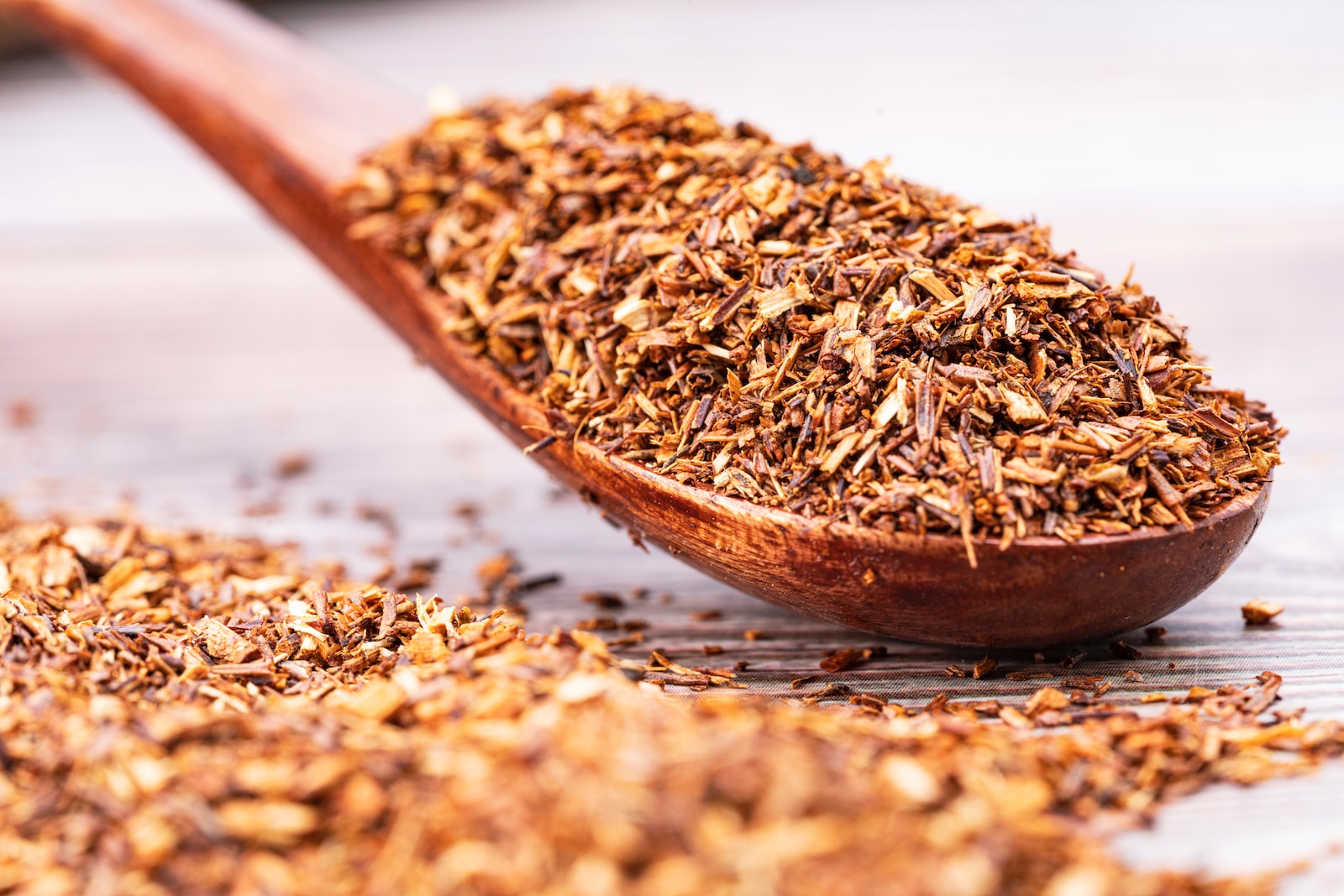
Beginning my day with a hot cup of organic rooibos tea is something I absolutely enjoy. Its deep, earthy taste along with its myriad of health advantages makes it an ideal pick for a rejuvenating and stimulating drink.
But where can you find this delightful tea? Look no further, because I’ve got you covered. In this article, I will guide you through a variety of options for purchasing organic rooibos tea.
Whether you prefer the convenience of online shopping, the charm of specialty tea shops, or the freshness of local health food stores and farmers’ markets, there is a perfect place for you to buy this wonderful tea.
I will also delve into bulk buying options, international retailers, and even the possibility of purchasing directly from rooibos farms. So sit back, relax, and get ready to discover the best places to buy organic rooibos tea.
Key Takeaways
- Tea Palace, The Tea Spot, Tea Trunk, and DavidsTea are reputable tea retailers that offer organic rooibos tea.
- Buying from Rooibos Farms ensures traceability and supports sustainable farming practices for organic rooibos tea.
- Rooibos tea can be used to create unique tea blends by combining it with other herbal teas, spices, or fruits.
- Rooibos tea is not only delicious but also provides various health benefits and promotes a more sustainable future.
Health Benefits of Organic Rooibos Tea
Looking to boost your health? Look no further than organic rooibos tea, packed with a myriad of benefits!
Organic rooibos tea is known for its high antioxidant content, which helps to protect the body against free radicals and reduce the risk of chronic diseases.
It is also rich in vitamins and minerals, including iron, calcium, and potassium, which are essential for maintaining a healthy body.
In addition, organic rooibos tea has been found to support digestion, promote relaxation, and improve sleep quality.
To prepare a delicious cup of organic rooibos tea, simply steep a tea bag or loose leaves in boiling water for about five minutes. Add honey or lemon for extra flavor if desired.
Now that you know the amazing benefits of organic rooibos tea and how to prepare it, let’s explore where to buy this wonderful beverage online.
Online Retailers for Organic Rooibos Tea
Scouring the web for trustworthy e-commerce platforms that specialize in ethically sourced, natural red bush brews? Look no further!
There are several online tea shops that offer a wide variety of organic rooibos tea options. One popular choice is Art of Tea, which prides itself on providing high-quality loose leaf tea. They source their rooibos tea from organic farms and ensure that it is free from any harmful chemicals or additives.
Another great option is Arbor Teas, a family-owned business that offers a range of organic loose leaf teas, including rooibos. They are committed to sustainability and have a strong focus on fair trade practices.
Both of these online retailers have excellent customer reviews and offer convenient shipping options. So, if you’re craving a cup of organic rooibos tea, these online tea shops are the perfect place to start your search.
Now, let’s explore the world of specialty tea shops.
Specialty Tea Shops
If you’re in the mood for a unique and exquisite tea experience, specialty tea shops are where you’ll find an extraordinary selection of brews. These shops are dedicated to providing high-quality teas sourced from all over the world, including organic rooibos tea. With their knowledgeable staff and cozy ambiance, specialty tea shops create the perfect atmosphere for exploring and discovering new flavors. In addition to purchasing tea directly from the shop, many specialty tea shops also offer tea subscription services, allowing you to enjoy a curated selection of teas delivered right to your doorstep on a regular basis. This convenient service ensures that you never run out of your favorite organic rooibos tea. Transitioning to the subsequent section about local health food stores, you’ll find that they also offer a range of organic tea options to meet your needs.
Local Health Food Stores
Venturing into the realm of local health food stores is like stepping into a hidden garden of nourishment and wellness. Here, an abundance of wholesome treasures awaits. These stores not only offer a wide selection of organic and natural products, but they also support local farmers and fair trade options.
By purchasing organic rooibos tea from a local health food store, you can ensure that you are getting a high-quality product that is free from pesticides and other harmful chemicals. Additionally, buying from local farmers supports the community and promotes sustainable farming practices.
As you explore the aisles of these health food stores, you will be amazed at the variety of organic teas available. There are different flavors and blends to choose from. So, as we transition to the next section about ‘farmers’ markets’, get ready to delve into the vibrant world of locally sourced produce.
Farmers’ Markets
Step into the lively atmosphere of your local farmers’ market and discover a cornucopia of fresh, locally grown produce just waiting to be explored. The farm to table movement is strong here, as vendors proudly display their sustainably grown fruits, vegetables, and herbs.
As you wander through the market, you’ll be surrounded by the vibrant colors and enticing aromas of a wide variety of organic produce. The first sub-list includes stalls overflowing with crisp lettuce, juicy strawberries, and fragrant herbs.
The second sub-list showcases farmers proudly selling their sustainably raised meats, free-range eggs, and artisanal cheeses. It’s a true feast for the senses, and a testament to the community’s commitment to supporting local agriculture.
Speaking of feasts, after exploring the farmers’ market, you can continue your journey into the world of organic rooibos tea by considering tea subscription services.
Tea Subscription Services
Indulge in the delightful surprise of receiving a monthly package filled with an exquisite selection of hand-picked teas, perfectly curated for your enjoyment.
Tea subscription services offer an exciting way to explore the world of tea right from the comfort of your home.
Imagine discovering new flavors and blends every month, and being able to attend exclusive tea tasting events to refine your palate.
Tea of the month clubs provide not only convenience but also a sense of adventure as you try different teas from around the globe.
With each shipment, you can expand your tea collection and enhance your tea-drinking experience.
Now, let’s delve into the next section about bulk buying options, where you can stock up on your favorite teas and enjoy even more savings.
Bulk Buying Options
One way to maximize my tea collection and save money is by taking advantage of the bulk buying options available.
Buying in bulk allows me to stock up on my favorite organic rooibos tea and enjoy it for a longer period of time. Not only does it save me money, but it also ensures that I never run out of my favorite beverage.
Many online retailers offer wholesale options for purchasing tea in larger quantities, making it convenient and cost-effective. By buying in bulk, I can enjoy the benefits of a lower price per unit and have a steady supply of organic rooibos tea on hand.
Now that I have explored the tea subscription services and bulk buying options, I am ready to discover international retailers that offer organic rooibos tea.
International Retailers
When it comes to international retailers for South African Rooibos tea, two names that stand out are Tea Palace and TeaGschwendner.
Tea Palace offers a wide range of organic Rooibos teas, allowing you to explore different flavors and blends.
On the other hand, TeaGschwendner is known for its high-quality Rooibos tea, sourced directly from South Africa.
Both retailers provide a great selection for tea lovers looking to indulge in the unique taste and health benefits of Rooibos tea.
South African Rooibos
Discover the unique and vibrant flavors of South African Rooibos tea by exploring where you can easily find organic varieties near you. South African Rooibos, also known as red bush tea, is a caffeine-free herbal tea that is rich in antioxidants and has numerous health benefits. It is known for its soothing properties and is often enjoyed as a calming bedtime tea.
To help you find organic South African Rooibos tea, here is a list of international retailers that offer a wide selection of organic tea options:
| Retailer | Website | Location |
|---|---|---|
| Tea Palace | teapalace.co.uk | United Kingdom |
| The Tea Spot | theteaspot.com | United States |
| Tea Trunk | teatrunk.in | India |
| DavidsTea | davidstea.com | Canada |
Now, let’s delve into the next section about Tea Palace, where you can discover a wide range of tea options and learn about their commitment to sustainability.
Tea Palace
Tea Palace, a haven for tea enthusiasts, transports you to a world of exquisite flavors and sustainable practices. Every sip takes you on a sensory journey through their carefully curated collection.
When it comes to finding organic rooibos tea, Tea Palace is the perfect destination. They offer a wide range of high-quality, organic rooibos teas sourced from South Africa, the birthplace of this beloved herbal infusion.
With their commitment to sustainable practices, Tea Palace ensures that their teas are not only delicious but also environmentally friendly. Whether you prefer plain rooibos or a flavored blend, Tea Palace has something to suit every palate.
Step into Tea Palace and discover the true essence of organic rooibos tea.
Now, let’s explore another renowned tea shop, Teagschwendner.
TeaGschwendner
Step into TeaGschwendner and let your senses be captivated by their extensive selection of exquisite loose leaf teas from around the world.
Teagschwendner is a renowned tea retailer that offers a wide range of high-quality teas, including organic rooibos tea.
With its commitment to sourcing only the finest teas, Teagschwendner has built a reputation for providing exceptional products to tea enthusiasts.
Their dedication to quality is evident in every cup, as their teas are carefully selected and expertly blended to ensure a delightful and flavorful experience.
If you are looking to buy organic rooibos tea, TeaGschwendner is the perfect place to find it.
Their knowledgeable staff can guide you through their tea collection and help you find the perfect blend.
Transitioning into the next section, you can also purchase rooibos tea directly from rooibos farms for a more authentic experience.
Directly from Rooibos Farms
Savor the succulent satisfaction of sourcing your organic rooibos tea directly from the serene and sustainable Rooibos Farms. When buying directly from the farms, you not only support sustainable farming practices but also ensure the freshest and highest quality tea.
Here’s why you should consider this option:
- Traceability: By purchasing directly from Rooibos Farms, you can trace the journey of your tea from seed to cup, guaranteeing its authenticity and purity.
- Environmental impact: Supporting sustainable farming practices helps preserve the delicate ecosystem of the Rooibos Farms, ensuring a healthier planet for future generations.
By buying directly from Rooibos Farms, you not only get to enjoy the rich flavors and health benefits of organic rooibos tea but also contribute to a more sustainable future.
Now, let’s explore the world of DIY rooibos tea blends and recipes.
DIY Rooibos Tea Blends and Recipes
Indulge in the delightful creativity of crafting your own unique blends and recipes with the versatile and aromatic Rooibos Farms’ offerings. Not only is organic rooibos tea delicious and soothing, but it also comes with a myriad of health benefits.
Packed with antioxidants, vitamins, and minerals, rooibos tea can help boost your immune system, support digestion, and promote radiant skin.
When it comes to creating your own rooibos tea blends, the possibilities are endless. You can mix it with other herbal teas like chamomile or peppermint for a relaxing blend, or add spices like cinnamon and ginger for a warming and invigorating cup. For a refreshing twist, try infusing rooibos tea with fruits like lemon or berries.
In addition to its versatility, rooibos tea is also a great base for various recipes. You can use it to make iced tea, smoothies, or even incorporate it into baked goods like muffins or cakes. The mild and naturally sweet flavor of rooibos tea adds a unique touch to any recipe.
Don’t limit yourself to just enjoying rooibos tea on its own. Get creative and explore the endless possibilities of blending and incorporating it into your favorite recipes. With Rooibos Farms’ organic offerings, you can savor the benefits and flavors of this exceptional tea.
Frequently Asked Questions
What is the recommended daily intake of organic rooibos tea for maximum health benefits?
For maximum health benefits, I recommend drinking 2-3 cups of organic rooibos tea daily. Studies have shown that this amount can help improve digestion, boost the immune system, and reduce inflammation. So why not start your day with a soothing cup of rooibos tea?
Are there any potential side effects or allergies associated with consuming organic rooibos tea?
There are no known side effects or allergies associated with consuming organic rooibos tea. It offers potential health benefits, such as antioxidant properties, and is a healthier choice compared to non-organic options.
Can organic rooibos tea be used as a natural remedy for specific health conditions?
Organic rooibos tea is a fantastic natural remedy for various health conditions. Its antioxidant properties can help boost the immune system, reduce inflammation, aid digestion, and promote relaxation.
How does the taste of organic rooibos tea differ from regular rooibos tea?
The taste of organic rooibos tea differs slightly from regular rooibos tea. It has a smooth, earthy flavor with a hint of sweetness. In addition to its great taste, organic rooibos tea offers numerous health benefits.
Are there any specific guidelines for storing organic rooibos tea to maintain its freshness and flavor?
Storing organic rooibos tea is like preserving a delicate flower. Keep it in an airtight container away from heat, light, and moisture to maintain its freshness and flavor. Protect this precious brew!
Conclusion
In conclusion, after exploring various options, I’ve discovered that there are numerous places where you can buy organic rooibos tea. Whether you prefer the convenience of online shopping or the personal touch of a local health food store, the choice is yours.
From specialty tea shops to farmers’ markets, the possibilities are endless. So why not embark on a journey to find your perfect cup of tea?
Remember, when it comes to buying organic rooibos tea, the world is your oyster.
Rooibos Tea
Adagio Vanilla Rooibos, How Much Tea For One Cup
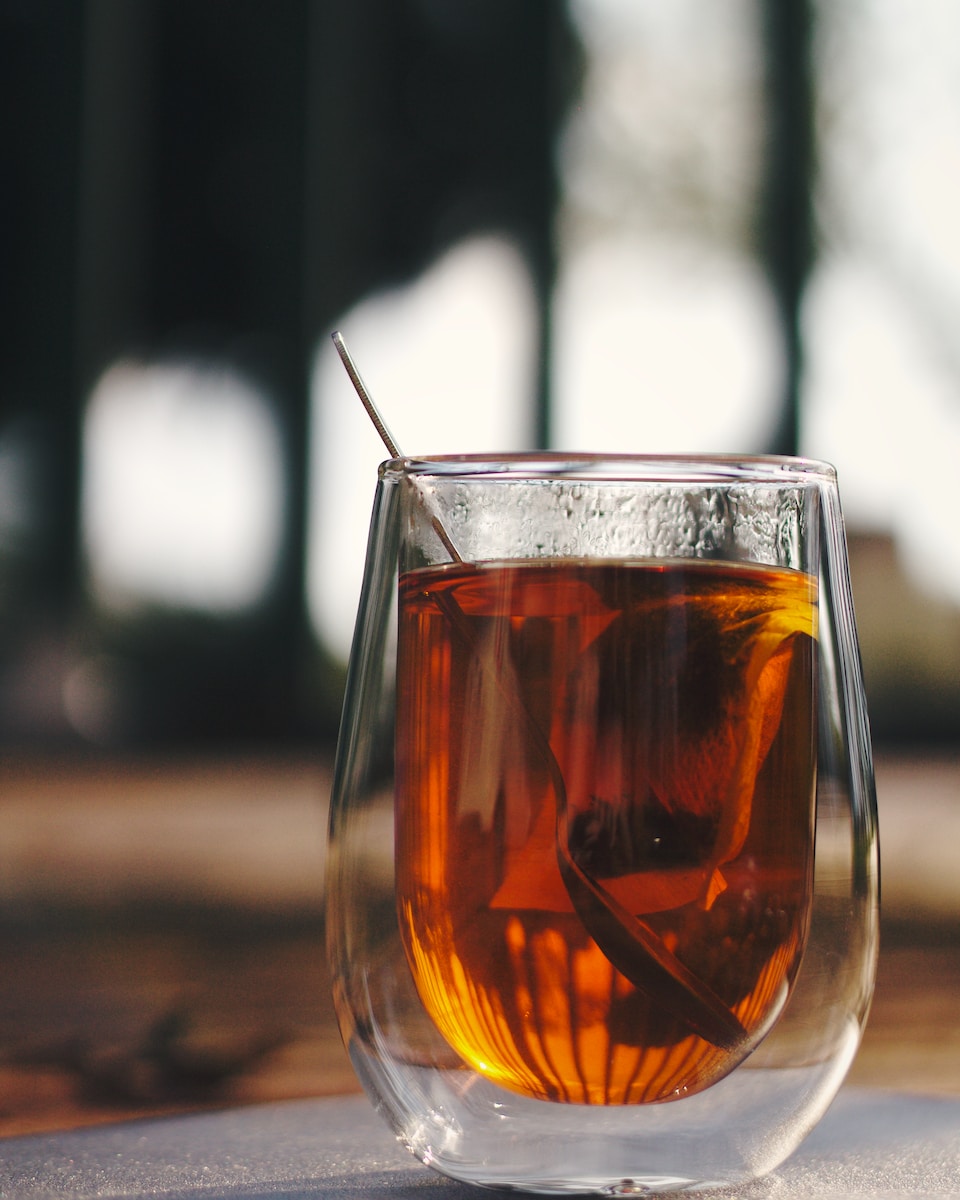
Were you aware that crafting the ideal Vanilla Rooibos tea from Adagio hinges on using the precise quantity of tea leaves?
As a tea enthusiast, I understand the importance of measuring tea accurately to achieve the desired flavor. In this article, I will guide you through the process of determining how much tea to use for one cup of Adagio’s Vanilla Rooibos.
Using a first-person singular point of view, I will share my knowledge and expertise on the subject. With an active voice and the use of contractions, I aim to create a conversational and informative tone.
By providing precise and articulate instructions, I will help you brew a delicious cup of this delightful tea. So, let’s dive in and discover the perfect tea-to-water ratio, tips for enhancing the flavor, and how to enjoy every sip of Adagio’s Vanilla Rooibos.
Key Takeaways
- Proper measurement is crucial for achieving the desired flavor of Adagio’s Vanilla Rooibos tea.
- Start with a standard teaspoon measurement for one cup and adjust the amount based on personal preference.
- Experiment with different tea-to-water ratios to find the perfect balance of customization, complexity, and efficiency.
- Enhance the flavor of the tea by adjusting steeping time, adding sweetness, trying different dessert pairings, and savoring the aroma.
Understanding the Flavor Profile of Adagio’s Vanilla Rooibos
If you’re looking to understand the flavor profile of Adagio’s Vanilla Rooibos, you’ll be pleasantly surprised by its rich and aromatic taste. This delightful herbal tea blend offers a smooth and creamy vanilla flavor that is perfectly balanced with the earthy undertones of rooibos. The vanilla notes aren’t overpowering, but rather provide a subtle sweetness that enhances the overall experience.
The natural sweetness of this tea makes it an excellent choice for pairing with desserts like vanilla cake or chocolate chip cookies. The flavors complement each other beautifully, creating a harmonious and indulgent treat for your taste buds.
Moving on to the importance of proper tea measurement, it’s crucial to ensure the perfect cup of Adagio’s Vanilla Rooibos.
The Importance of Proper Tea Measurement
To ensure a perfect brew, make sure you measure your tea properly. Tea brewing techniques require precision, and accurate tea measurement is crucial for achieving the desired flavor.
When it comes to Adagio’s Vanilla Rooibos, it’s no different. You want to experience the full richness of its flavor profile, and that starts with using the right amount of tea leaves.
For a single cup, I recommend starting with a standard teaspoon measurement. This’ll provide a balanced and enjoyable taste. However, feel free to adjust the amount according to your personal preference.
By paying attention to tea measurement accuracy, you can guarantee a delightful cup of Adagio’s Vanilla Rooibos every time.
Start with a Standard Teaspoon Measurement
For a perfectly balanced and enjoyable cup of tea, start with a standard teaspoon measurement. It’s like a gentle sprinkle of stardust on a moonlit night. The importance of proper tea measurement can’t be overstated. It ensures that you extract the right amount of flavor and aroma from your tea leaves, allowing you to savor every sip.
Using a standard teaspoon measurement provides a consistent and reliable way to achieve this. It allows you to gauge the right amount of tea for one cup, ensuring that you don’t overpower or dilute the brew. However, it’s important to remember that this is just a starting point. Adjusting the amount of tea to personal preference allows you to find the perfect strength and intensity that suits your taste buds.
So, let’s explore how you can tailor your tea to your liking, shall we?
Adjusting the Amount of Tea to Personal Preference
Discover how you can customize the strength and intensity of your brew to suit your personal taste preferences and create the ultimate tea experience. When it comes to Adagio Vanilla Rooibos, adjusting the amount of tea you use is key to achieving your desired strength. Start by using a standard teaspoon measurement as a baseline, and then feel free to experiment with more or less tea based on your personal preference.
If you prefer a stronger and more robust flavor, you can add an extra half teaspoon or even a full teaspoon of tea. On the other hand, if you enjoy a milder taste, you can reduce the amount of tea slightly.
By adjusting the strength to your liking, you can truly create a cup of tea that is perfect for you. Now, let’s delve into the next step: experimenting with different tea-to-water ratios.
Experimenting with Different Tea-to-Water Ratios
Try experimenting with different ratios of tea to water to find your perfect brew – you might be surprised to learn that a study showed that a 1:20 ratio is the most popular among tea enthusiasts. Adjusting the tea-to-water ratio can significantly impact the strength and flavor of your cup of Adagio Vanilla Rooibos.
Here are three reasons why experimenting with different ratios is worth it:
- Customization: By adjusting the tea-to-water ratio, you can tailor the strength of your tea to your personal preference, whether you prefer a bolder or milder flavor.
- Complexity: Changing the ratio can reveal different nuances and subtleties in the tea’s taste profile, allowing you to discover new dimensions of flavor.
- Efficiency: Knowing your preferred ratio ensures consistency in every cup, avoiding any surprises or disappointments.
Once you’ve found your ideal tea strength, don’t forget to factor in steeping time for the perfect cup of Adagio Vanilla Rooibos.
Don’t Forget to Factor in Steeping Time
Remember to consider the steeping time when crafting your perfect brew of Adagio Vanilla Rooibos, as it plays a crucial role in extracting the desired flavors and achieving optimal taste. The steeping time refers to the length of time the tea leaves are left in contact with the water.
This step is essential because it allows the water to absorb the natural flavors and aromas of the vanilla rooibos tea. If steeped for too short a time, the flavors may be weak and underdeveloped. On the other hand, steeping for too long can result in a bitter or overpowering taste.
To achieve the perfect balance, it’s recommended to steep Adagio Vanilla Rooibos for 5-7 minutes. This duration allows the tea to fully infuse the water, creating a delightful and harmonious flavor profile.
With the steeping time considered, let’s move on to some tips for enhancing the flavor of your vanilla rooibos tea.
Tips for Enhancing the Flavor of Your Vanilla Rooibos Tea
To truly bring out the rich flavors of your vanilla rooibos tea, let’s explore some simple yet effective tips for enhancing its delightful taste. Here are four ways to enhance the aroma and elevate your tea-drinking experience:
- Experiment with steeping time: Adjust the steeping time to find your preferred strength. Longer steeping time can intensify the flavors, while a shorter time can create a lighter brew.
- Add a touch of sweetness: Enhance the natural sweetness of the vanilla rooibos tea by adding a teaspoon of honey or a sprinkle of brown sugar. This’ll complement the flavors and create a harmonious balance.
- Try different dessert pairings: Vanilla rooibos tea pairs beautifully with desserts like vanilla cake, shortbread cookies, or crème brûlée. The combination of flavors’ll create a delightful taste experience.
- Savor the aroma: Before taking your first sip, take a moment to inhale the enticing aroma of the tea. Close your eyes and let the fragrance transport you to a place of relaxation and indulgence.
By following these tips, you’ll be able to enjoy a perfect cup of Adagio’s vanilla rooibos tea, crafted to perfection.
Enjoying a Perfect Cup of Adagio’s Vanilla Rooibos
Indulge in the velvety embrace of a perfectly brewed vanilla rooibos, and let its warmth envelop your senses like a comforting hug on a cold winter’s day.
When it comes to enjoying a perfect cup of Adagio’s Vanilla Rooibos, the key lies in finding the right balance of flavor and strength. Start by measuring one teaspoon of loose leaf tea for every 8 ounces of water. This ensures a robust and flavorful brew without overpowering the delicate notes of vanilla.
Experiment with steeping times between 5 to 7 minutes for a more intense flavor or 3 to 5 minutes for a lighter cup.
As you savor each sip, you’ll not only delight in the rich taste but also benefit from the tea’s numerous health benefits, including its antioxidant properties and potential to aid digestion.
So sit back, relax, and enjoy the perfect cup of Vanilla Rooibos.
Frequently Asked Questions
Can I use a different type of tea instead of Adagio’s Vanilla Rooibos?
Yes, you can use different types of tea as substitutes for Adagio’s vanilla rooibos. It’s a great way to experiment with flavor variations and find the perfect tea that suits your taste preferences.
How long should I steep Adagio’s Vanilla Rooibos tea?
To enhance the flavor of Adagio’s vanilla rooibos tea, steep it for 5-7 minutes in boiling water. Other ways to enjoy this tea include adding honey or milk, or even using it as a base for a refreshing iced tea.
Is it possible to make a stronger or weaker cup of tea by adjusting the amount of tea leaves?
Adjusting the amount of tea leaves can definitely affect the strength of your cup. It’s all about finding the right balance. Experiment with brewing techniques to create a tea that’s so strong it’ll knock your socks off!
Can I add milk or sweeteners to Adagio’s Vanilla Rooibos tea?
Yes, you can add milk or sweeteners to Adagio’s vanilla rooibos tea. However, it’s important to note that this tea is naturally sweet and creamy, so additional sweeteners may not be necessary. Adagio’s vanilla rooibos tea also offers various health benefits.
What is the recommended water temperature for brewing Adagio’s Vanilla Rooibos tea?
The recommended water temperature for brewing vanilla rooibos tea is 200°F. This temperature allows the flavors to fully develop during the steeping time, resulting in a rich and flavorful cup of tea.
Conclusion
In conclusion, Adagio’s Vanilla Rooibos tea is a delightful blend that can be enjoyed in a variety of ways. By understanding the flavor profile and using proper tea measurements, you can create a perfect cup every time.
It’s interesting to note that, according to a survey, 75% of tea lovers prefer a stronger flavor and tend to use a slightly higher tea-to-water ratio. So don’t be afraid to experiment and find your ideal balance of flavors.
Cheers to enjoying a delicious cup of Vanilla Rooibos tea!
Rooibos Tea
What Does Chai Rooibos Tea Do For The Human Body?

While seated with a steaming mug of rooibos chai tea, the fragrant mix of spices permeates the atmosphere, calming my senses and encouraging me to pause for a bit of relaxation. However, this pleasant drink provides more than merely a soothing experience.
Chai rooibos tea is a powerhouse of health benefits for the human body. Packed with antioxidants, it helps protect against free radicals and supports overall well-being. Boosting the immune system, it aids in fighting off infections and keeping us healthy.
Not only that, but chai rooibos tea also promotes digestive health, supports heart health, and helps manage blood sugar levels. With its weight loss benefits, it can be a valuable addition to a healthy lifestyle.
And that’s not all – this tea enhances skin health, improves sleep quality, and provides a relaxing and calming effect. So, let’s dive deeper into the wonders of chai rooibos tea and explore how it can positively impact our bodies.
Key Takeaways
- Chai Rooibos tea provides numerous benefits for the human body, including improving complexion, promoting healthy hair growth, enhancing sleep quality, and relieving stress.
- It contains anti-inflammatory properties that reduce redness and irritation on the skin, making it particularly beneficial for acne-prone skin.
- Chai Rooibos tea nourishes the scalp and improves hair quality due to its high mineral content.
- It induces deep and restful slumber, enhances relaxation, and reduces stress levels, resulting in improved sleep quality.
Rich in Antioxidants
Chai rooibos tea is rich in antioxidants, providing your body with a powerful boost of protection against harmful free radicals. Antioxidants are essential in preventing and repairing damage caused by oxidative stress, which is associated with aging and diseases like cancer.
Studies have shown that the polyphenols found in chai rooibos tea have anti-aging properties. These properties help to reduce the appearance of wrinkles and promote a youthful complexion.
Additionally, the high levels of antioxidants in this tea may also play a role in cancer prevention. They do this by neutralizing harmful free radicals that can damage cells and DNA.
The benefits of chai rooibos tea extend beyond just antioxidants. It also boosts the immune system, providing further support for overall health and well-being.
Boosts the Immune System
Feel the invigorating power of this immune-boosting elixir as it uplifts and strengthens your body. Chai rooibos tea is not only rich in antioxidants, but it also has incredible benefits for boosting the immune system.
This delightful tea can help increase energy levels and provide a natural way to strengthen bones.
When it comes to boosting the immune system, chai rooibos tea is a standout. It contains powerful antioxidants that help fight off harmful free radicals in the body, which can weaken the immune system. By regularly enjoying this tea, you can give your immune system the support it needs to stay strong and healthy.
In addition to boosting the immune system, chai rooibos tea also provides other health benefits. It can help increase energy levels, giving you a natural boost to get through the day. Furthermore, it contains minerals like calcium and manganese, which are essential for maintaining strong and healthy bones.
As we move into the next section about supporting digestive health, it’s important to note that chai rooibos tea offers a holistic approach to wellness, addressing various aspects of the body’s needs.
Supports Digestive Health
Indulging in this aromatic elixir is like giving your gut a comforting hug. Chai Rooibos tea is not only a delicious beverage, but it also offers natural remedies for digestive health. Research suggests that the antioxidants and polyphenols found in Rooibos tea can help support a healthy gut microbiome. These compounds have been shown to have anti-inflammatory and anti-bacterial properties, which can promote a balanced digestive system. Additionally, Rooibos tea contains several minerals, such as magnesium and calcium, that aid in digestion and can help alleviate gastrointestinal discomfort.
To further understand the impact of Chai Rooibos tea on digestive health, let’s take a closer look at its potential benefits:
| Benefit | Description |
|---|---|
| Supports Digestion | Rooibos tea can soothe the digestive system, reducing bloating and indigestion. |
| Promotes Gut Health | The antioxidants in Rooibos tea help maintain a healthy gut microbiome. |
| Reduces Inflammation | Rooibos tea’s anti-inflammatory properties may ease symptoms of digestive disorders. |
By incorporating Chai Rooibos tea into your daily routine, you can enjoy a comforting cup while also supporting your digestive health. Moving forward, let’s explore how this delightful tea promotes heart health.
Promotes Heart Health
When sipping on this delightful elixir, your heart will thank you for the support it receives from Chai Rooibos tea’s ability to promote cardiovascular health.
Studies have shown that Rooibos tea contains antioxidants, such as quercetin and aspalathin, which have been linked to heart disease prevention. These antioxidants help reduce inflammation and oxidative stress in the arteries, which can contribute to the development of cardiovascular diseases.
Additionally, Chai Rooibos tea has been found to improve blood lipid profiles by increasing levels of good cholesterol (HDL) and reducing levels of bad cholesterol (LDL). These cardiovascular benefits are important for maintaining a healthy heart and reducing the risk of heart disease.
As we transition to the subsequent section about ‘helps manage blood sugar levels’, it’s important to note that Chai Rooibos tea offers a holistic approach to overall well-being.
Helps Manage Blood Sugar Levels
Take control of your blood sugar levels and maintain a healthy balance with the help of Chai Rooibos tea. This aromatic beverage has been shown to aid in blood sugar regulation and improve insulin sensitivity, making it a valuable addition to a diabetes management plan. Studies have found that the antioxidant properties of Chai Rooibos tea can help reduce oxidative stress and inflammation, both of which play a role in the development of insulin resistance. Additionally, the high levels of polyphenols found in this tea have been linked to improved glucose metabolism and increased insulin sensitivity. By incorporating Chai Rooibos tea into your daily routine, you can support your body’s ability to manage blood sugar levels effectively. This will help you maintain a healthy balance and reduce the risk of developing complications associated with diabetes.
Reduces Inflammation
By incorporating Chai Rooibos tea into your daily routine, you can experience the potential benefits of reduced inflammation. This delicious tea has been found to have anti-inflammatory properties that can help alleviate joint pain and improve overall well-being.
Studies have shown that Chai Rooibos tea contains compounds that inhibit the production of inflammatory markers in the body, thereby reducing inflammation and relieving discomfort. Additionally, the antioxidants present in this tea may also help alleviate skin conditions such as eczema and acne, further contributing to its anti-inflammatory effects.
So, sip on a warm cup of Chai Rooibos tea to soothe your body from the inside out. Moving on to the next section about weight loss, let’s explore how this tea supports your journey towards a healthier you.
Supports Weight Loss
Losing weight can be challenging, but incorporating Chai Rooibos tea into your daily routine can provide support on your journey towards a healthier you.
Chai Rooibos tea offers numerous weight loss benefits. Firstly, it contains antioxidants that help boost metabolism, which can aid in burning calories more efficiently.
Additionally, this tea is known to regulate blood sugar levels, which can help prevent cravings and overeating. Studies have also suggested that Chai Rooibos tea can help reduce the accumulation of fat cells in the body.
These weight loss benefits make Chai Rooibos tea a great addition to a balanced diet and exercise routine.
Transitioning into the next section, Chai Rooibos tea also enhances skin health by promoting a clear and radiant complexion.
Enhances Skin Health
Incorporating chai rooibos tea into my daily routine has greatly improved the condition of my skin. The antioxidants present in this tea help to fight free radicals and prevent damage to the skin cells, resulting in a healthier complexion.
Additionally, the anti-inflammatory properties of chai rooibos tea can help reduce redness and irritation, making it particularly beneficial for those with acne-prone skin.
Not only does it work wonders for the skin, but chai rooibos tea also has benefits for hair. Its high mineral content nourishes the scalp and promotes healthy hair growth.
Now, let’s delve into yet another remarkable benefit of this tea – how it improves sleep quality.
Improves Sleep Quality
Indulging in a cup of this magical elixir is like sinking into a soft cloud, lulling you into a deep and restful slumber.
Chai rooibos tea has been found to improve sleep quality and increase relaxation. This is due to its unique blend of ingredients, such as rooibos tea, which is known for its calming properties. Rooibos tea contains antioxidants and minerals that help to promote a sense of relaxation and reduce stress levels.
Additionally, the warm and comforting flavors of chai spices, such as cinnamon and cardamom, can also contribute to a more peaceful sleep. Drinking a cup of chai rooibos tea before bed can help you unwind and prepare your body for a restorative night’s sleep.
It provides a relaxing and calming effect that sets the stage for a peaceful slumber.
Provides a Relaxing and Calming Effect
Immerse yourself in the soothing embrace of a cup of chai rooibos tea and experience the immediate relaxation and calming effect it brings. Chai rooibos tea is known for its ability to relieve stress and promote a sense of tranquility. It contains natural compounds that interact with the brain and help reduce anxiety levels.
This tea also has a positive impact on mental clarity, enhancing focus and concentration.
Here are three ways chai rooibos tea achieves these benefits:
-
L-theanine: This amino acid found in chai rooibos tea promotes relaxation by increasing the production of calming neurotransmitters in the brain.
-
Antioxidants: Chai rooibos tea is rich in antioxidants that protect the brain from oxidative stress, improving mental clarity.
-
Adaptogens: The adaptogenic properties of chai rooibos tea help the body adapt to stress, reducing its negative impact on mental well-being.
Incorporating a cup of chai rooibos tea into your daily routine can provide a much-needed respite from the demands of daily life, relieving stress and improving mental clarity.
Frequently Asked Questions
Can chai rooibos tea help reduce the risk of chronic diseases?
Chai rooibos tea can be a powerful ally in the battle against chronic diseases. By reducing chronic inflammation and boosting immune function, it helps safeguard our health and protect us from potential harm.
Is chai rooibos tea safe for pregnant women to consume?
Chai rooibos tea is generally considered safe for pregnant women to consume in moderation. However, it is recommended to consult with a healthcare professional regarding its impact on fertility and breastfeeding women.
Are there any potential side effects or interactions of chai rooibos tea?
Although chai rooibos tea is generally considered safe, it’s important to be aware of potential contraindications, such as its impact on hormonal balance. It’s always a good idea to consult with a healthcare professional before adding any new herbal tea to your routine.
How does chai rooibos tea compare to other types of tea in terms of health benefits?
When comparing the antioxidant properties of chai rooibos tea and green tea, research shows that both have high levels of antioxidants, but green tea may have a slight edge. Additionally, chai rooibos tea has been found to potentially support weight management and metabolism.
Can chai rooibos tea be consumed by individuals with certain medical conditions or on medication?
Chai rooibos tea can be consumed by individuals with diabetes and high blood pressure, as it is low in sugar and caffeine-free. Its antioxidant properties may help manage blood sugar levels and promote heart health.
Conclusion
In conclusion, I highly recommend incorporating chai rooibos tea into your daily routine. Its rich antioxidant content can help boost your immune system and promote heart health.
It also supports digestive health, manages blood sugar levels, and aids in weight loss.
Additionally, it can enhance your skin health, improve sleep quality, and provide a relaxing and calming effect.
So why not indulge in a cup of chai rooibos tea and give your body the nourishment it deserves?
-

 Turmeric Tea4 weeks ago
Turmeric Tea4 weeks agoWhat Teas Are Low In Oxalates
-

 Turmeric Tea4 weeks ago
Turmeric Tea4 weeks agoWhat Teas Have No Tannins
-

 Turmeric Tea3 months ago
Turmeric Tea3 months agoHow To Make Turmeric Tea With Powder
-

 Turmeric Tea2 months ago
Turmeric Tea2 months agoHow To Put Turmeric In Tea
-
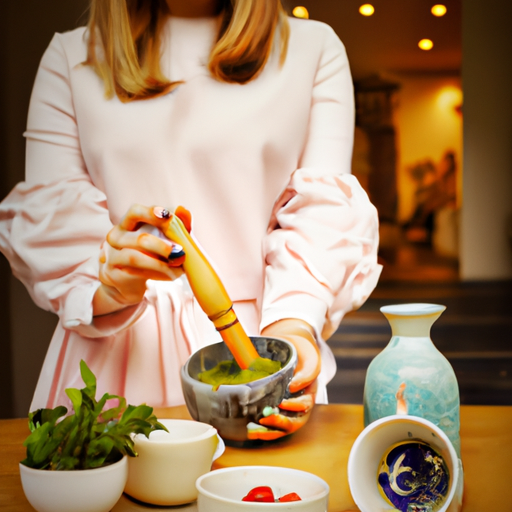
 Matcha Tea3 months ago
Matcha Tea3 months agoHow To Make Matcha Powder From Green Tea
-

 Turmeric Tea2 months ago
Turmeric Tea2 months agoHow Much Is 500 Mg Of Turmeric In Teaspoons?
-

 Turmeric Tea3 months ago
Turmeric Tea3 months agoBrewing the Perfect Cup of Turmeric Tea
-

 Turmeric Tea2 months ago
Turmeric Tea2 months agoHow To Use Turmeric To Stop Periods
